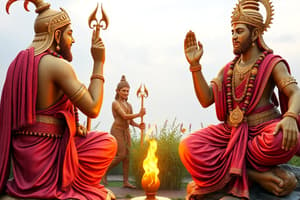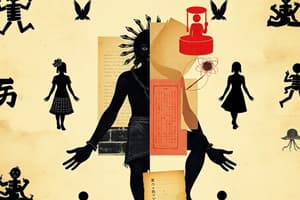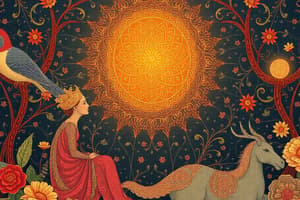Podcast
Questions and Answers
What is the significance of 'moksha' in the context of Hindu beliefs?
What is the significance of 'moksha' in the context of Hindu beliefs?
- Moral duties individuals must follow based on their caste.
- The cycle of birth, death, and rebirth.
- The illusion of the material world that prevents one from seeing reality.
- The ultimate liberation from the cycle of birth, death, and rebirth. (correct)
How does the concept of 'karma' primarily influence the Hindu understanding of life?
How does the concept of 'karma' primarily influence the Hindu understanding of life?
- It determines the caste to which a person is born.
- It dictates the specific god or goddess that an individual should worship.
- It establishes the illusion that the world is permanent.
- It affects the soul’s journey through the cycle of reincarnation based on one's actions. (correct)
How does the Hindu concept of 'Maya' affect a person's understanding of reality?
How does the Hindu concept of 'Maya' affect a person's understanding of reality?
- It represents the illusion that the material world is the ultimate reality, obscuring the truth of Brahman. (correct)
- It signifies the devotion to a personal god through love and worship.
- It encourages individuals to renounce all worldly possessions.
- It denotes the performance of good deeds without attachment.
What distinguishes 'Bhakti Yoga' from other forms of yoga in Hinduism?
What distinguishes 'Bhakti Yoga' from other forms of yoga in Hinduism?
How do the Vedas contribute to the understanding of Hindu philosophy?
How do the Vedas contribute to the understanding of Hindu philosophy?
What is the role of 'Atman' in relation to 'Brahman' within Hindu philosophy?
What is the role of 'Atman' in relation to 'Brahman' within Hindu philosophy?
How does the principle of 'Ahimsa' influence ethical behavior in Hinduism?
How does the principle of 'Ahimsa' influence ethical behavior in Hinduism?
In the context of the four stages of life (ashramas), what is unique about the 'Vanaprastha' stage?
In the context of the four stages of life (ashramas), what is unique about the 'Vanaprastha' stage?
Which of the following best describes the role of 'Dharma' in Hinduism?
Which of the following best describes the role of 'Dharma' in Hinduism?
What is the significance of the 'Trimurti' in Hindu cosmology?
What is the significance of the 'Trimurti' in Hindu cosmology?
How can Hinduism be described in terms of its theistic perspective?
How can Hinduism be described in terms of its theistic perspective?
What is the primary purpose of performing 'Puja' in Hinduism?
What is the primary purpose of performing 'Puja' in Hinduism?
Which of the following best defines 'Samsara' in Hinduism?
Which of the following best defines 'Samsara' in Hinduism?
What is the ultimate goal of 'Jnana Yoga'?
What is the ultimate goal of 'Jnana Yoga'?
How does Hinduism view the origin of human existence?
How does Hinduism view the origin of human existence?
Why is Hinduism referred to as an 'umbrella term'?
Why is Hinduism referred to as an 'umbrella term'?
How is the Hindu caste system traditionally linked to the concepts of karma and dharma?
How is the Hindu caste system traditionally linked to the concepts of karma and dharma?
What distinguishes 'Karma Yoga' from other types of yoga?
What distinguishes 'Karma Yoga' from other types of yoga?
How do Hindu festivals like Diwali and Holi contribute to the spiritual life of practitioners?
How do Hindu festivals like Diwali and Holi contribute to the spiritual life of practitioners?
What are the Four Goals of Life for Hindus?
What are the Four Goals of Life for Hindus?
Flashcards
Samsara
Samsara
The cycle of birth, death, and rebirth in which all living beings are caught until they achieve liberation (moksha).
Reincarnation
Reincarnation
The belief that after death, the soul is reborn into another body until it achieves moksha.
Moksha
Moksha
The ultimate goal of liberation from samsara, achieved when one’s soul merges with Brahman.
Monism
Monism
Signup and view all the flashcards
Brahman
Brahman
Signup and view all the flashcards
Atman
Atman
Signup and view all the flashcards
Karma
Karma
Signup and view all the flashcards
Dharma
Dharma
Signup and view all the flashcards
Maya
Maya
Signup and view all the flashcards
Henotheistic
Henotheistic
Signup and view all the flashcards
Mandir
Mandir
Signup and view all the flashcards
Mantra
Mantra
Signup and view all the flashcards
Avatar
Avatar
Signup and view all the flashcards
Puja
Puja
Signup and view all the flashcards
Dharma (Goal of Life)
Dharma (Goal of Life)
Signup and view all the flashcards
Artha
Artha
Signup and view all the flashcards
Kama
Kama
Signup and view all the flashcards
Brahmacharya
Brahmacharya
Signup and view all the flashcards
Grihastha
Grihastha
Signup and view all the flashcards
Vanaprastha
Vanaprastha
Signup and view all the flashcards
Study Notes
- This presents key terms, concepts, and practices within Hinduism
Core Concepts
- Samsara: The continuous cycle of birth, death, and rebirth, trapping beings until they achieve liberation (moksha).
- Reincarnation: The soul's rebirth into different bodies after death, continuing until moksha is attained.
- Moksha: Liberation from samsara, achieved through the merging of one's soul with Brahman.
- Monism: The belief in the oneness of reality, particularly the identity of Atman (individual soul) and Brahman (universal soul).
- Brahman: The ultimate, unchanging reality and universal consciousness in Hinduism.
- Atman: The individual soul, considered eternal and identical to Brahman but temporarily separated by ignorance.
- Karma: The law of cause and effect, where good actions lead to positive outcomes and bad actions to negative ones, influencing the soul's journey.
- Dharma: The moral law and duties individuals must follow, varying based on factors like age, caste, gender, and life stage.
- Maya: The illusion of the material world, which obscures the ultimate reality.
- Polytheistic Aspect: Hinduism is often viewed as polytheistic due to its numerous deities.
- Henotheistic Application: Some Hindus focus worship on a single god while acknowledging others as manifestations of Brahman.
- Mandir: A Hindu temple is a place for worship, rituals, and connecting with the divine.
- Mantra: Sacred sounds or phrases repeated during meditation or prayer, believed to possess spiritual power.
- Avatar: A divine incarnation, especially of Vishnu, such as Rama or Krishna.
- Puja: A Hindu ritual of worship involving offerings, prayers, and ceremonies.
The Four Goals in Life for Hindus
- Dharma: Fulfilling righteous duty and ethical responsibilities.
- Artha: Pursuing prosperity, wealth, and success.
- Kama: Seeking pleasure, love, and emotional fulfillment.
- Moksha: Achieving liberation and union with Brahman.
The Four Hindu Stages of Life
- Brahmacharya: The student stage focused on learning and spiritual development.
- Grihastha: The householder stage involving marriage, family, and societal contributions.
- Vanaprastha: The hermit stage involving gradual withdrawal from worldly responsibilities for spiritual growth.
- Sannyasa: The renunciant stage focused on renouncing possessions and seeking liberation through meditation.
- These stages primarily apply to males, but the philosophy extends to all.
Hindu View on Human Existence
- Humans originate from Brahman, and the true nature is Atman.
- Ignorance (avidya) and attachment to the material world (maya) obscure this connection.
- The goal is to realize the true nature, attain moksha, and reunite with Brahman.
Origin of Hinduism
- It originates in the Indus Valley.
- The term "Hindu" derives from the Indus River.
- It includes diverse beliefs, practices, and philosophies without a central founder.
The Caste System
- The caste system divides society into four varnas:
- Brahmins: Priests and scholars.
- Kshatriyas: Warriors and rulers.
- Vaishyas: Merchants and farmers.
- Shudras: Laborers and servants.
- Dalits exist outside the traditional system.
- The system is tied to karma and dharma.
- Though officially abolished, its influence persists in some areas.
Ahimsa
- Ahimsa emphasizes non-violence and respect for all living beings.
- Harming others negatively affects karma and can prolong samsara.
The Trimurti
- The Trimurti consists of three major gods:
- Brahma: The creator.
- Vishnu: The preserver.
- Shiva: The destroyer.
- These gods embody the cyclical nature of existence.
Hindu Scriptures
- Main scriptures include:
- Vedas: Oldest sacred texts in Sanskrit.
- Upanishads: Philosophical texts on Brahman and Atman.
- Bhagavad Gita: Spiritual dialogue between Arjuna and Krishna.
- Ramayana and Mahabharata: Epic narratives conveying values of duty, righteousness, and devotion.
Yoga and Its Types
- Yoga means "union" and leads to spiritual discipline and union with the divine.
- The three main types are:
- Karma Yoga: Selfless action.
- Bhakti Yoga: Devotion.
- Jnana Yoga: Knowledge.
- The purpose is to transcend the ego, achieve spiritual insight, and realize oneness with Brahman.
The Illusion of the World (Maya)
- The physical world distracts from the truth of Brahman.
- Attachment to worldly things causes suffering.
- Recognizing the illusion of the material world allows the achievement of liberation.
Rituals and Milestones
- Rituals vary by region and community but often include:
- Puja: Daily worship.
- Rites of Passage: Birth ceremonies, initiation rites, weddings, and death rituals.
- Festivals symbolize triumph over evil and divine protection. -Diwali:Marks the beginning of the new Hindu year. -Holi: A festival celebrated with colors. -Mahashivratri: A night to worship Lord Shiva. -Navaratri: Celebrated over nine nights, worshipping the universal mother Durga.
- These rituals hold symbolic significance of purification, devotion, and honoring gods.
Studying That Suits You
Use AI to generate personalized quizzes and flashcards to suit your learning preferences.




